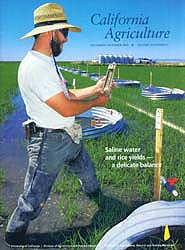All Issues

Saline water and rice yields - a delicate balance
Cover:
With a production value of $138 million in 2001, rice is an important California field crop. Grown in flooded conditions, rice is also one of the crops considered most sensitive to salinity. In a series of field and greenhouse studies, scientists with UC and USDA determined that rice is significantly more sensitive to salinity than previous guidelines suggest. By carefully managing water in fields, particularly at growth stages when rice is most salt-sensitive, farmers can limit crop damage and optimize yields. Aove, Former UC Davis post-graduate researcher Bill Thomas takes measurements in a grower's rice field, whcich was outfitted with large metal rings to study the impacts of various salinity levels in soil and water. Photo by Jack Kelly Clark .

California cattle industry at the crossroads
Cover:
Beef cattle and calves are among California's top commmodities, with a farm-gate value of $1.36 billion in 2001. But with increasing packer consolidation and declining demand for red meat, the state's cattle industry faces major challenges (p. 152). An option for some ranchers may be to pursue niche markets such as grass-fed beef (p. 151). In the dairy industry, organic production has emerged as a niche market (p. 157). Ranked as California's number one commodity, dairy generated $4.6 billion in 2001 and spurred growth in the hay sector, which now constitutes the largest crop acreage in the state. Choices made by alfalfa growers and dairy producers can help protect water quality and aquatic life (pp. 148, 150, 163). Research beef cattle graze at the UC Sierra Foothills Research and Extension Center. Photo by Jack Kelly Clark.

UC responds to Klamath conundrum
Also: Special focus on irrigation effiency
Cover:
From the Klamath Basin to the Rio Grande, water is a much-disputed commodity in California. Increasingly, agricultural users must compete with environmental and urban needs for scarce water supplies. In this issue of California Agriculture, news and research articles focus on how growers and other water users can irrigate more efficiently and effectively. The cover story explores how UC has responded to the water crisis in the Klamath Basin, where hundreds of growers did not receive irrigation water in 2001 due to a severe drought and concerns about protecting three endangered fish species. Through research and outreach, the University plays a critical role in ensuring that precious water is utilized to the best advantage for wildlife, crops, and people. Cover graphic by Davis Krauter

A warmer California:
Assessing the impacts of climate change
Cover:
A new sensor orbiting the Earth aboard NASA's Terra satellite is collecting the most detailed measurements ever made of the sea's surface temperature.
The Moderate-resolution Imaging Spectro-radiometer (MODIS) is measuring sea surface temperature at twice the accuracy of previous satellites. Taken Jan. 1-8, 2001, this image shows cold water upwelling near the coast of Peru, and joining the South Equatorial Current, which flows westward across the Pacific Ocean.
Thermal expnasion of seawater and widespread loss of land ice due to global warming have very lilely contributed to the documented rise on sea level (1 to 2 millimeters annually) during the 20th century.
Image by Jesse Allen, based on data provided by the MODIS OCEAN Team and the university of Miami Rosenstiel School of Marine and Atmospheric Science Remote Sensing Group.

Youth & Work: The Ride Ahead
Cover:
In 1999, 29% of California's 9.35 million children under 18 were living at or below poverty level, placing them at significant risk for compromised educational performance. At the same time, global forces have transformed the U.S. economy into a fast-paced, highly competitive, skills-based arena - one in which innovation and changing conditions result in a constant turnover of occupations. While the ride may be bumpy, the University seeks to provide research, guidance and support to help make the transition from school to the world of work as smooth as possible for today's youth. Teenagers enjoyed the California State Fair in Sacramento on 2000. Photo by John Stumbos.

Agricultural easements:
New tool for farmland
Cover:
To prevent the creep of urbanization into farmland, about 34 land trusts and open space districts have been pursuing agricultural conservation easements in California. While conservation easements have been used to protect natural resources for many years, the use of easements to protect agriculture is relatively new. The first land trust the nation specifically targeting farmland (Marin Agricultural Land Trust) was formed in California in 1980. In recent years, easements have grown in popularity as the preferred farmland preservation tool. The top portion of the cover illustration shows the 519-acre Cook property on Sonoma Mountain, where the Sonoma County Agricultural Preservation and Open Space District (SCAPOSD) purchased an easement that restricts future uses of the land to grazing and possible crop production. Top photo courtesy of SCAPOSD
November-December 2002
Volume 56, Number 6
Volume 56, Number 6





